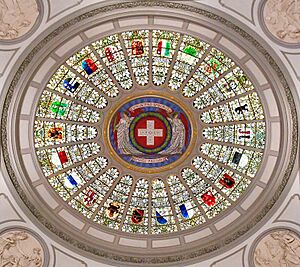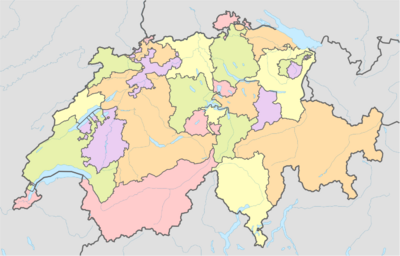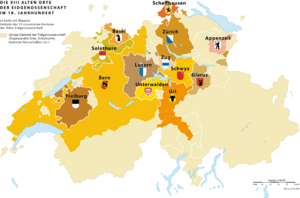Cantons of Switzerland facts for kids
Quick facts for kids Swiss cantonsSchweizer Kantone (German) Cantons suisses (French) Cantoni svizzeri (Italian) Chantuns svizras (Romansh) |
|
|---|---|
| Also known as: Stände, États, Stati |
|
| Category | Federated state |
| Location | Switzerland |
| Found in | Regions |
| Created | 13th century |
| Number | 26 cantons (as of 1979) |
| Populations | 16,003 (Appenzell Innerrhoden) – 1,487,969 (Canton of Zürich) |
| Areas | 37 km2 (14 sq mi) – 7,105 km2 (2,743 sq mi) |
| Government | List of cantonal executives of Switzerland |
| Subdivisions | Districts and municipalities |
The 26 cantons of Switzerland are like the states or provinces that make up the country of Switzerland. Imagine Switzerland as a big puzzle, and each canton is a unique piece!
The first three groups of cantons were called the Waldstätte, meaning 'forest settlements'. Over time, the number of cantons grew. From 1353 to 1481, there were eight cantons, known as the Acht Orte. Later, from 1513 to 1798, there were thirteen cantons, called the Dreizehn Orte.
Before 1848, each canton was almost like its own country. They had their own borders, armies, and even their own money! This changed when Switzerland became a federal state in 1848, bringing them closer together. The word canton has been widely used since the 1800s.
The number of cantons has changed over time. In 1803, it grew to 19. By 1815, it was 22. The canton of Jura joined as the 23rd canton in 1979. In 1999, the official number became 26. This was because some "half-cantons" were officially recognized as full cantons.
Cantons come in different sizes. The smallest is Basel-Stadt, which is only 37 square kilometers. The largest is Grisons, at 7,105 square kilometers. Their populations also vary a lot, from about 16,000 people in Appenzell Innerrhoden to 1.5 million in Zürich.
Contents
History of Swiss Cantons
In the 1500s, the Old Swiss Confederacy had 13 independent cantons. These were split into two types:
- Five rural states (countryside areas): Uri, Schwyz, Unterwalden, Glarus, and Appenzell.
- Eight urban states (cities): Zürich, Bern, Luzern, Zug, Basel, Fribourg, Solothurn, and Schaffhausen.
Even though they were technically part of the Holy Roman Empire, these cantons became truly independent after the Swiss defeated Emperor Maximilian I in 1499.
The old system changed when the Helvetic Republic was formed in 1798, after the French invaded Switzerland. During this time, cantons were just administrative areas and didn't have their own power. But this republic didn't last long.
In 1803, cantons got their power back with the Act of Mediation. Switzerland became a federation of states again, with 19 cantons. By 1815, three more cantons joined: Valais, Neuchâtel, and Geneva.
After some conflicts, Switzerland became a modern federal state in 1848. The cantons kept a lot of their independence. However, they could no longer have their own armies or deal with other countries on their own.
How Cantons Work

The Swiss Federal Constitution says that cantons are independent. But their independence is limited by federal (national) laws. The federal government handles things like:
- The armed forces
- Money
- Postal service
- Phone and internet
- Immigration
- Foreign relations
- Major laws
- Customs duties
Each canton has its own:
- Constitution: Its own set of rules.
- Legislature: A group of people who make laws.
- Executive: A group of people who run the government.
- Police: To enforce laws.
- Courts: To handle legal cases.
Most cantonal legislatures are single-chamber parliaments, meaning they have one main group of lawmakers. Their size can vary from 58 to 200 members. In a few cantons, like Appenzell Innerrhoden and Glarus, citizens still gather in large outdoor assemblies called Landsgemeinden to vote on laws.
Cantons are in charge of many important things that affect daily life. These include:
- Healthcare: Hospitals and medical services.
- Welfare: Support for people in need.
- Law enforcement: Local police.
- Public education: Schools and learning.
- Taxation: Collecting taxes from people and businesses.
Each canton also decides its own official language(s). Cantons can even make agreements with other cantons or with foreign countries!
The cantonal constitutions also decide how much freedom the local municipalities (towns and villages) have. Most municipalities can collect taxes and make their own local laws. Some even have their own police.
Just like at the national level, citizens in each canton can directly participate in making decisions. They can ask for a public vote to change the cantonal constitution or laws. They can also reject laws or spending plans passed by the parliament.
Swiss citizens are citizens of a specific municipality and the canton it belongs to. Cantons play a role in granting citizenship, though the process usually starts at the local level.
Switzerland only has one national public holiday (August 1st). Other public holidays are decided by each canton.
List of Cantons
The cantons are listed here in the order they appear in the federal constitution. This order shows their historical importance and when they joined the Swiss Confederation.
| Arms |
Code | Name in official language(s) | Name in English | As a Swiss canton since | Capital | GDP (2020) in million CHF |
GDP per capita (2020) in CHF |
Population |
Area (km2) | Density (per km2) |
No. munic. (2018) | Official languages | |
|---|---|---|---|---|---|---|---|---|---|---|---|---|---|
| 1 |
|
ZH | Zürich | Zurich | 1351 | Zurich | 149,004 | 96,359 | 1,553,423 | 1,729 | 898 | 166 | German |
| 2 |
|
BE | Bern; Berne | Bern / Berne | 1353 | Bern | 80,209 | 77,027 | 1,043,132 | 5,960 | 175 | 347 | German, French |
| 3 |
|
LU | Luzern | Lucerne | 1332 | Lucerne | 28,176 | 67,936 | 416,347 | 1,494 | 279 | 83 | German |
| 4 |
|
UR | Uri | Uri | 1291 |
Altdorf | 1,985 | 54,006 | 36,819 | 1,077 | 34 | 20 | German |
| 5 |
|
SZ | Schwyz | Schwyz | 1291 |
Schwyz | 9,876 | 61,223 | 162,157 | 908 | 179 | 30 | German |
| 6 |
|
OW | Obwalden | Obwalden / Obwald | 1291 or 1315 (as part of Unterwalden) |
Sarnen | 2,564 | 67,453 | 38,108 | 491 | 78 | 7 | German |
| 7 |
|
NW | Nidwalden | Nidwalden / Nidwald | 1291 (as Unterwalden) |
Stans | 2,867 | 66,209 | 43,520 | 276 | 158 | 11 | German |
| 8 |
|
GL | Glarus | Glarus | 1352 | Glarus | 2,763 | 67,849 | 40,851 | 685 | 60 | 3 | German |
| 9 |
|
ZG | Zug | Zug / Zoug | 1352 | Zug | 20,029 | 156,210 | 128,794 | 239 | 539 | 11 | German |
| 10 |
|
FR | Fribourg; Freiburg | Fribourg / Freiburg | 1481 | Fribourg | 19,180 | 59,263 | 325,496 | 1,671 | 195 | 136 | French, German |
| 11 |
|
SO | Solothurn | Solothurn / Soleure | 1481 | Solothurn | 18,029 | 65,237 | 277,462 | 790 | 351 | 109 | German |
| 12 |
|
BS | Basel-Stadt | Basel-Stadt / Basel-City | 1501 (as Basel until 1833/1999) | Basel | 37,168 | 189,354 | 201,156 | 37 | 5,444 | 3 | German |
| 13 |
|
BL | Basel-Landschaft | Basel-Landschaft / Basel-Country | 1501 (as Basel until 1833/1999) | Liestal | 20,567 | 70,866 | 292,955 | 518 | 566 | 86 | German |
| 14 |
|
SH | Schaffhausen | Schaffhausen / Schaffhouse | 1501 | Schaffhausen | 7,244 | 87,569 | 83,107 | 298 | 278 | 26 | German |
| 15 |
|
AR | Appenzell Ausserrhoden | Appenzell Ausserrhoden / Appenzell Outer-Rhodes | 1513 (as Appenzell until 1597/1999) | Herisau | 3,190 | 57,601 | 55,309 | 243 | 228 | 20 | German |
| 16 |
|
AI | Appenzell Innerrhoden | Appenzell Innerrhoden / Appenzell Inner-Rhodes | 1513 (as Appenzell until 1597/1999) | Appenzell | 1,043 | 64,358 | 16,293 | 172 | 94 | 6 | German |
| 17 |
|
SG | St. Gallen | St. Gallen / St. Gall | 1803 |
St. Gallen | 38,041 | 74,210 | 514,504 | 2,031 | 253 | 77 | German |
| 18 |
|
GR | Graubünden; Grischun; Grigioni | Grisons / Graubünden | 1803 |
Chur | 14,519 | 72,754 | 200,096 | 7,105 | 28 | 108 | German, Romansh, Italian |
| 19 |
|
AG | Aargau | Aargau | 1803 |
Aarau | 43,590 | 63,177 | 694,072 | 1,404 | 494 | 212 | German |
| 20 |
|
TG | Thurgau | Thurgau / Thurgovia | 1803 |
Frauenfeld | 17,208 | 61,190 | 282,909 | 992 | 285 | 80 | German |
| 21 |
|
TI | Ticino | Ticino / Tessin | 1803 |
Bellinzona | 29,311 | 83,450 | 350,986 | 2,812 | 125 | 115 | Italian |
| 22 |
|
VD | Vaud | Vaud | 1803 |
Lausanne | 56,898 | 70,250 | 814,762 | 3,212 | 254 | 309 | French |
| 23 |
|
VS | Valais; Wallis | Valais | 1815 |
Sion | 19,194 | 55,313 | 348,503 | 5,224 | 67 | 126 | French, German |
| 24 |
|
NE | Neuchâtel | Neuchâtel | 1815/1857 |
Neuchâtel | 15,343 | 87,080 | 175,894 | 802 | 219 | 31 | French |
| 25 |
|
GE | Genève | Geneva | 1815 |
Geneva | 51,976 | 102,876 | 506,343 | 282 | 1,792 | 45 | French |
| 26 |
|
JU | Jura | Jura | 1979 |
Delémont | 4,687 | 63,643 | 73,709 | 839 | 88 | 55 | French |
| - | CH | Schweizerische Eidgenossenschaft; Confédération suisse; Confederazione Svizzera; Confederaziun svizra |
Swiss Confederation | 1815/1848 |
(Bern) | 694,662 | 80,418 | 8,670,300 | 41,291 | 210 | 2,222 | German, French, Italian, Romansh |
The two-letter codes for Swiss cantons are used a lot, like on car license plates. For example, CH-SZ is for the canton of Schwyz. The "CH" comes from "Confœderatio Helvetica," which is Latin for "Helvetian Confederation."
Half-Cantons: A Special Case
Six of the 26 cantons used to be called "half-cantons." This term is not official anymore, but it helps explain their history. There are three pairs of these half-cantons:
- Unterwalden (split into Obwalden and Nidwalden)
- Basel (split into Basel-Stadt and Basel-Landschaft)
- Appenzell (split into Appenzell Ausserrhoden and Appenzell Innerrhoden)
The reasons for these divisions are historical. For example, the old canton of Appenzell split in 1597 because of religious differences. Appenzell Innerrhoden remained Catholic, while Appenzell Ausserrhoden became Protestant. The historical canton of Basel divided in 1833 after people in the countryside wanted more say in the government.
Even though they were called "half-cantons," they are almost equal to other cantons today. There are only two main differences:
- They elect only one member to the Swiss Council of States instead of two.
- In national votes about changing the constitution, their vote counts as half of a full canton's vote.
You might notice that Swiss coins minted since 1983 show 23 stars. This includes the canton of Jura, which joined later. However, the coins don't show all 26 cantons, even though that's the official number now.
Names in National Languages
Here are the names of each canton in English and Switzerland's official languages: German, French, Italian, and Romansh. The name in the canton's own official language is shown in bold.
| Abbr | English | German | French | Italian | Romansh |
|---|---|---|---|---|---|
| AG | Aargau; Argovia | Aargau | Argovie | Argovia | ' |
| AI | Appenzell Innerrhoden; Appenzell Inner-Rhodes | Appenzell Innerrhoden | Appenzell Rhodes-Intérieures | Appenzello Interno | |
| AR | Appenzell Ausserrhoden; Appenzell Outer-Rhodes | Appenzell Ausserrhoden | Appenzell Rhodes-Extérieures | Appenzello Esterno | |
| BS | Basel-Stadt; Basel-City | Basel-Stadt | Bâle-Ville | Basilea Città | |
| BL | Basel-Landschaft; Basel-Country | Basel-Landschaft | Bâle-Campagne | Basilea Campagna | |
| BE | Bern; Berne | Bern | Berne | Berna | |
| FR | Fribourg; Friburg | Freiburg | Fribourg | Friburgo | |
| GE | Genève; Geneva | Genf | Genève | Ginevra | |
| GL | Glarus; Glaris | Glarus | Glaris | Glarona | |
| GR | Grisons; Graubünden | Graubünden | Grisons | Grigioni | Grischun |
| JU | Jura | Jura | Jura | Giura | |
| LU | Lucerne | Luzern | Lucerne | Lucerna | |
| NE | Neuchâtel | Neuenburg | Neuchâtel | Neuchâtel | Neuchâtel |
| NW | Nidwalden; Nidwald | Nidwalden | Nidwald | Nidvaldo | |
| OW | Obwalden; Obwald | Obwalden | Obwald | Obvaldo | |
| SH | Schaffhausen; Schaffhouse | Schaffhausen | Schaffhouse | Sciaffusa | |
| SZ | Schwyz | Schwyz | Schwyz (or Schwytz) | Svitto | |
| SO | Solothurn; Soleure | Solothurn | Soleure | Soletta | |
| SG | St. Gallen; St Gall | St. Gallen | Saint-Gall | San Gallo | |
| TG | Thurgau; Thurgovia | Thurgau | Thurgovie | Turgovia | |
| TI | Ticino; Tessin | Tessin | Tessin | Ticino | |
| UR | Uri | Uri | Uri | Uri | |
| VS | Valais; Wallis | Wallis | Valais | Vallese | |
| VD | Vaud | Waadt | Vaud | Vaud | |
| ZG | Zug; Zoug | Zug | Zoug | Zugo | |
| ZH | Zürich; Zurich | Zürich | Zurich | Zurigo |
Images for kids
See also
 In Spanish: Cantones de Suiza para niños
In Spanish: Cantones de Suiza para niños




